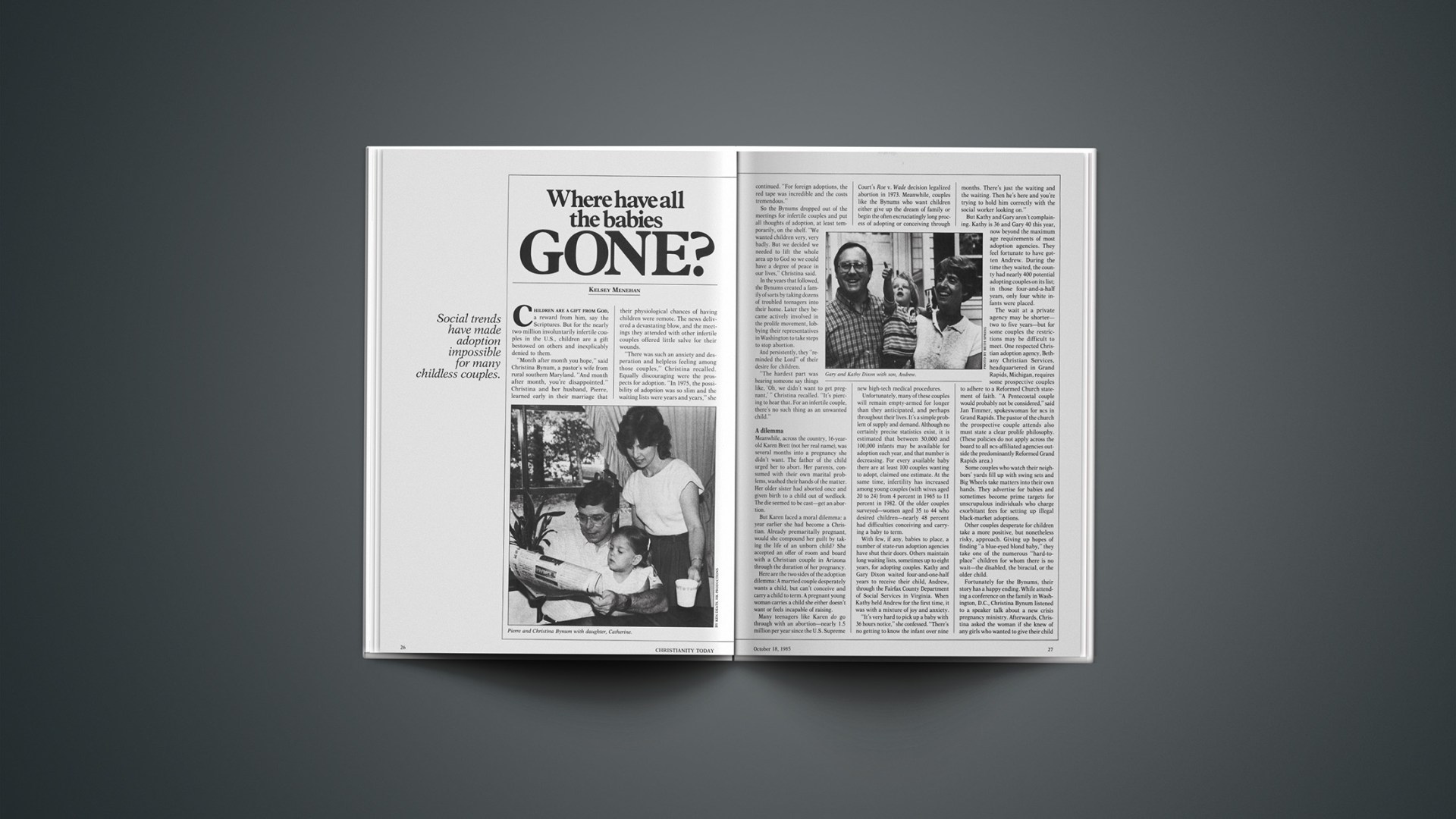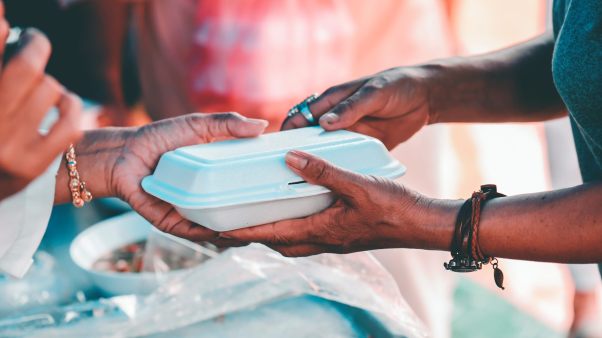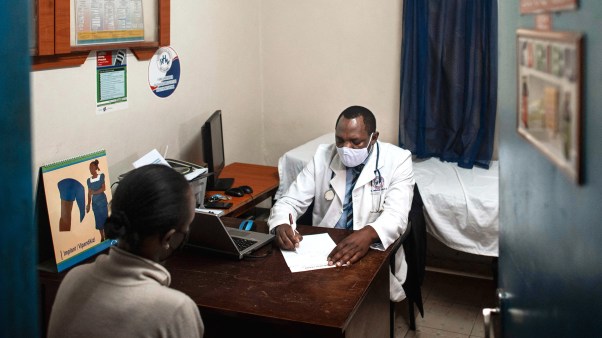Social trends have made adoption impossible for many childless couples.
Children are a gift from god, a reward from him, say the Scriptures. But for the nearly two million involuntarily infertile couples in the U.S., children are a gift bestowed on others and inexplicably denied to them.
“Month after month you hope,” said Christina Bynum, a pastor’s wife from rural southern Maryland. “And month after month, you’re disappointed.” Christina and her husband, Pierre, learned early in their marriage that their physiological chances of having children were remote. The news delivered a devastating blow, and the meetings they attended with other infertile couples offered little salve for their wounds.
“There was such an anxiety and desperation and helpless feeling among those couples,” Christina recalled. Equally discouraging were the prospects for adoption. “In 1975, the possibility of adoption was so slim and the waiting lists were years and years,” she continued. “For foreign adoptions, the red tape was incredible and the costs tremendous.”
So the Bynums dropped out of the meetings for infertile couples and put all thoughts of adoption, at least temporarily, on the shelf. “We wanted children very, very badly. But we decided we needed to lift the whole area up to God so we could have a degree of peace in our lives,” Christina said.
In the years that followed, the Bynums created a family of sorts by taking dozens of troubled teenagers into their home. Later they became actively involved in the prolife movement, lobbying their representatives in Washington to take steps to stop abortion.
And persistently, they “reminded the Lord” of their desire for children.
“The hardest part was hearing someone say things like, ‘Oh, we didn’t want to get pregnant,’ ” Christina recalled. “It’s piercing to hear that. For an infertile couple, there’s no such thing as an unwanted child.”
A Dilemma
Meanwhile, across the country, 16-year-old Karen Brett (not her real name), was several months into a pregnancy she didn’t want. The father of the child urged her to abort. Her parents, consumed with their own marital problems, washed their hands of the matter. Her older sister had aborted once and given birth to a child out of wedlock. The die seemed to be cast—get an abortion.
But Karen faced a moral dilemma: a year earlier she had become a Christian. Already premaritally pregnant, would she compound her guilt by taking the life of an unborn child? She accepted an offer of room and board with a Christian couple in Arizona through the duration of her pregnancy.
Here are the two sides of the adoption dilemma: A married couple desperately wants a child, but can’t conceive and carry a child to term. A pregnant young woman carries a child she either doesn’t want or feels incapable of raising.
Many teenagers like Karen do go through with an abortion—nearly 1.5 million per year since the U.S. Supreme Court’s Roe v. Wade decision legalized abortion in 1973. Meanwhile, couples like the Bynums who want children either give up the dream of family or begin the often excruciatingly long process of adopting or conceiving through new high-tech medical procedures.
Unfortunately, many of these couples will remain empty-armed for longer than they anticipated, and perhaps throughout their lives. It’s a simple problem of supply and demand. Although no certainly precise statistics exist, it is estimated that between 30,000 and 100,000 infants may be available for adoption each year, and that number is decreasing. For every available baby there are at least 100 couples wanting to adopt, claimed one estimate. At the same time, infertility has increased among young couples (with wives aged 20 to 24) from 4 percent in 1965 to 11 percent in 1982. Of the older couples surveyed—women aged 35 to 44 who desired children—nearly 48 percent had difficulties conceiving and carrying a baby to term.
With few, if any, babies to place, a number of state-run adoption agencies have shut their doors. Others maintain long waiting lists, sometimes up to eight years, for adopting couples. Kathy and Gary Dixon waited four-and-one-half years to receive their child, Andrew, through the Fairfax County Department of Social Services in Virginia. When Kathy held Andrew for the first time, it was with a mixture of joy and anxiety.
“It’s very hard to pick up a baby with 36 hours notice,” she confessed. “There’s no getting to know the infant over nine months. There’s just the waiting and the waiting. Then he’s here and you’re trying to hold him correctly with the social worker looking on.”
But Kathy and Gary aren’t complaining. Kathy is 36 and Gary 40 this year, now beyond the maximum age requirements of most adoption agencies. They feel fortunate to have gotten Andrew. During the time they waited, the county had nearly 400 potential adopting couples on its list; in those four-and-a-half years, only four white infants were placed.
The wait at a private agency may be shorter—two to five years—but for some couples the restrictions may be difficult to meet. One respected Christian adoption agency, Bethany Christian Services, headquartered in Grand Rapids, Michigan, requires some prospective couples to adhere to a Reformed Church statement of faith. “A Pentecostal couple would probably not be considered,” said Jan Timmer, spokeswoman for BCS in Grand Rapids. The pastor of the church the prospective couple attends also must state a clear prolife philosophy. (These policies do not apply across the board to all BCS-affiliated agencies outside the predominantly Reformed Grand Rapids area.)
Some couples who watch their neighbors’ yards fill up with swing sets and Big Wheels take matters into their own hands. They advertise for babies and sometimes become prime targets for unscrupulous individuals who charge exorbitant fees for setting up illegal black-market adoptions.
Other couples desperate for children take a more positive, but nonetheless risky, approach. Giving up hopes of finding “a blue-eyed blond baby,” they take one of the numerous “hard-to-place” children for whom there is no wait—the disabled, the biracial, or the older child.
Fortunately for the Bynums, their story has a happy ending. While attending a conference on the family in Washington, D.C., Christina Bynum listened to a speaker talk about a new crisis pregnancy ministry. Afterwards, Christina asked the woman if she knew of any girls who wanted to give their child up for adoption. A few weeks later, the woman called and told Christina about a pregnant girl who was being sheltered by her daughter in rural Arizona.
The girl’s name was Karen, and she wanted to give her child to a Christian couple. The legal documents complete, Christina and Pierre flew to Arizona and received their daughter, Catherine, directly from her birth mother’s arms.
Where Have All The Babies Gone?
The most prominent reason for the shortage of adoptable babies is probably abortion. Nearly 1.5 million abortions are performed each year. Ironically, that is nearly the same number of infertile couples who hope to adopt. But the availability of abortion to end unwanted pregnancies provides only part of the answer; more subtle attitudes throw barriers in the way of the adoption alternative.
One such barrier relates to the pregnant woman’s privacy: it no longer exists. “The legalization of abortion meant that young girls could make a confidential decision to terminate their pregnancy,” said Bill Pierce, director of the National Committee for Adoption, a proadoption lobby in Washington, D.C. “No one except the doctor knows.” On the other hand, that same privacy was not extended to girls who chose to carry their babies to term. Title IX of the education law requires school districts to “mainstream” a pregnant girl into regular classes, whereas in the past she might have gone away to an established maternity home. Today, a number of these homes operated by such experienced social service agencies as the Salvation Army, Catholic Charities, and the Florence Crittenden Foundation have had to close their doors due to high costs, thus reducing available housing by two-thirds.
“Public schools are off the hook,” Pierce said. “No longer do they have to pay for a girl’s tutoring outside. There’s no privacy. So if a girl doesn’t want everybody to know but still wants to continue her education, she has only one choice—abortion.”
In recent years, however, a number of prolife groups have begun to reach out to pregnant women, offering them more than one option in dealing with an embarrassing and oftentimes frightening situation. Juli Loesch of Prolifers for Survival estimates there may be as many as 4,500 individuals or groups now providing alternatives to abortion through such services as crisis counseling, shepherd homes in which girls can stay while carrying their child to term, job and career counseling, day care, and in some cases, adoption services.
A pioneer in the movement, Bob Pearson, a Catholic, began counseling pregnant girls near abortion clinics in Hawaii in 1968 soon after that state became the first to legalize abortion. Today, the Pearson Foundation’s 130 affiliated crisis pregnancy centers use advertising very similar to that of abortion clinics to attract young girls intent on ending their pregnancies. After receiving a free pregnancy test and viewing a 27-minute film that shows, among other things, Life magazine photos of a fetus and the aftermath of an abortion, nearly 80 percent of these girls choose to carry their child, according to Mike Byers, a spokesman in the Pearson Foundation’s St. Louis office.
Several newer groups employ similar tactics in reaching abortion-bound women. The Problem Pregnancy Center in Baton Rouge, Louisiana, opened four doors down from the city’s largest abortion clinic. “Girls come in thinking they’re in an abortion clinic,” said Larry Stocksdill, senior pastor of Bethany Baptist Church, which heavily supports the center with funds and volunteers. “We’re able to show them a 20-minute film that is very effective in convincing them not to have an abortion.” Both the Problem Pregnancy Center and Save-a-Baby (a crisis pregnancy ministry launched by Jerry Falwell) advertise their services in the Yellow Pages under the innocuous heading, “Pregnancy Counseling.”
Supporters of legal abortion have attacked such methods as deceptive and manipulative, claiming that prolifers care only about the unborn child and not its distraught mother. Director Jim Savley acknowledges that Save-a-Baby focuses on the unborn child, but not, he claims, at the expense of the mother. “The girls who come to us are in a life-threatening situation,” he said. “We exist to save the lives of babies and to turn the mothers around to Christ.”
Yet even girls who find the support they need to make a difficult decision not to abort may not choose adoption as a viable alternative. Recent studies reveal that more than 90 percent of pregnant teenagers who have their babies choose to parent rather than relinquish them for adoption. In the 1960s and early 1970s, just the opposite was true.
Fifteen years ago, Penny Salazar from Denver, Colorado, gave birth to a child out of wedlock and relinquished her for adoption. “In those days,” she recalled, “that’s what you did if you were unwed and pregnant; you gave up the child for adoption.” Although Penny feels she made a good decision for the baby, “I didn’t feel like I had a whole lot of options and support to do anything else.”
Today, Penny directs the Christian Action Council’s crisis pregnancy center in Denver, counseling young girls like she was, except that they generally see adoption as a distant third option, if it is considered at all, behind abortion or parenting. Even counselors at crisis pregnancy centers who strongly present adoption as a good choice have ed a substantial increase in those teens who choose to keep their babies. Sixty percent of Bethany Christian Services’ clients elect to keep their child, and “we’re biased toward adoption, of course,” said Patricia Gibson, BCS’s Virginia coordinator.
Pierce points again to “mainstreaming” as one reason teenagers decide to become parents instead of giving their child up for adoption. “There’s a lot of peer pressure in schools. Kids say things like, ‘If you didn’t want to keep it you’d have had an abortion, right? Who would give away their own flesh and blood?’ ” Karen Brett said the question she faced most often when she revealed that she planned to give her child up for adoption was this: “So why didn’t you abort?”
Increasing social acceptability of single-parent households may carry weight in decisions of some teenagers. In black neighborhoods, in particular, pregnant teens are expected to keep their children. In fact, adoption of black babies by black couples is so rare that it seems to constitute a cultural taboo. A number of prolife black pastors in the Washington, D.C., area met recently to discuss ways to combat this entrenched problem.
But Pierce points to a more compelling reason why teens aren’t considering adoption: some pregnancy counselors are not presenting the option effectively. “Some of these groups are not doing enough to encourage girls to consider adoption,” he said. “Many Christians open maternity homes but don’t believe in adoption. They don’t see it as the sound option it is.” Pierce urges prolifers to take a longer view. Preventing an abortion is basic, but a child’s chances for a successful and happy life are greatly increased if it is raised by a carefully chosen two-parent adoptive family.
The Christian Action Council, admits director Curtis Young, has been criticized for not being strong enough in recommending adoption as an alternative, but he counters by saying, “Adoption is an alternative to abortion, not the solution. The natural inclination is for the woman to want to raise the child. There’s great ambivalence. We don’t try to pressure her at all to come to a certain conclusion. We try to clarify what the influences are on her concerning each option—parenting or adoption. We want to help our clients obey God. Whether they parent or release for adoption, we believe there’s freedom in Christ and in the Word.”
Patricia Gibson thinks some pregnant women back off from considering adoption because the whole process, at least until recently, has been shrouded in secrecy. Most birth mothers relinquish their babies without receiving any information about the adoptive family. “I think confidentiality can go to unnecessary extremes,” Gibson said. “There’s a connotation of unpleasantness when you don’t know about something.” Bethany Christian Services, traditionally very conservative concerning confidentiality, has recently “opened up slightly,” allowing the birth mother to help select the adoptive parents and communicate with them indirectly by letters channeled through the agency.
Although open adoption may sound attractive to some birth mothers, Pierce warns that the process may scare off as many as it attracts. “Open adoption makes about as much sense as open marriage,” Pierce said. “These family relationships are permanent and irrevocable.… With open adoption, the child may show up 18 years later on the birth mother’s doorstep. Then where’s her privacy?”
The Costs
These controversies only increase the frustration of infertile couples. Because the number of babies is so limited, agencies often screen prospective couples rigorously.
Besides the emotional costs, there are the financial ones as well. Private adoption agencies charge between $2,500 and $8,000, which includes preadoption counseling, conducting a home study, paying for the birth mother’s medical bill, and legal fees. Independent adoptions, in which all legal arrangements are handled by a lawyer, can cost less, or much more, depending on whether the delivery has complications.
An independent adoption differs from an agency adoption in that the baby is usually placed directly in the adoptive parents’ home before the relinquishment papers have been finalized, and therein lies the greater risk. During the two- to six-month period after birth, the natural mother can change her mind. Such a trauma happened recently to a couple in Towson, Maryland, who were forced to return their child to the lawyer of the birth mother—after only ten days as proud new parents.
If political lobbying and demonstrations are the voice of the prolife movement, the growing, behind-the-scenes work of serving the needs of pregnant women is its heart. “I think you’ll see a whole lot more activity in this area,” says Jack Rameson, a Los Angeles attorney who had arranged several private adoptions. “Lots of people are realizing you can’t be against abortion and not come alongside the parent and child.”
But churches and prolife groups will face an uphill battle in making adoption a viable alternative to abortion. Beyond the issues of open versus closed adoptions or independent versus agency adoptions lies a negative public perception that may only be rooted out by an extended public relations campaign. At its heart may be the fact that the prime players in an adoption—the pregnant woman and the infertile couple—do not understand each other’s pain.
How many pregnant teenagers are told about the two million infertile couples who hope and pray daily for a baby? How many of the couples can sympathize with the fear and loneliness of a 16-year-old girl who thinks the only way out of her dilemma is an abortion?
A few like Karen, who gave her child to the Bynums, do know the other side of the story. When the Bynums arrived at the hospital and walked down the corridor, Karen held out their baby to them. The baby was wearing a T-shirt with the inscription, “I love my Mommy and Daddy.” Then the Bynums and Karen and her doctor prayed together, and Karen formally relinquished her child to the Bynums’ care.
“I was so happy to give life to someone else to start a family,” Karen said. “That excited me. It still excites me.” Karen has told her story to a number of high school audiences, and generally they are puzzled about her decision. What Karen tries to communicate is that love motivated her.
“I never had a father, really, growing up,” she said. “By giving my baby to the Bynums, I gave her a father. She needed that.”
Women traumatized by unwanted pregnancies may not immediately grasp the wonder of not only giving life to a child, but giving that life to another couple. But with the support of the Christian community, it seems likely that such an attitude of self-sacrificing love can be nurtured, and in time turn the tide on the adoption stigma.










